|
Two Technologies Hydrus
Highly customizable ultra-rugged waterproof handheld computer with 5-megapixel camera
(by Conrad H. Blickenstorfer, photography by Carol Cotton) [View video]
Two Technologies, headquartered in Horsham, PA, has been designing and manufacturing customizable, rugged handheld computer and terminal products for industrial and commercial applications for over 20 years. With over 400 GEM partners, 4,000 customers and over a million products in the field, their computers and terminals can be found in a multitude of different applications and fields. Most of Two Technologies' products are customized for specific applications by either the company itself or by VARs and OEMs, and the company prides itself on being able to generate custom graphics, firmware, keypads, logo tags, serial tags very quickly.
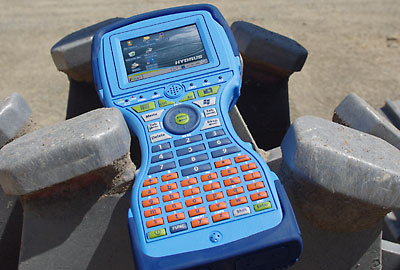
Two Technologies introduced the ultra-rugged Hydrus handheld computer as a highly customizable platform designed to provide maximum performance in the harshest environments. Dual rechargeable Li-Ion packs offer superb battery life, supporting a wide variety of field applications through several shifts. Its case is made of Xenoy, a resin developed by General Electric to provide chemical resistance, superior impact resistance even at low temperatures, and heat resistance under the worst of conditions.
The Hydrus, which weighs about 2.5 pounds with batteries installed, carries outstanding IP67/IP68 sealing, where the "6" stands for total protection against dust penetration, and the "8" for total protection against immersion in water. How total? Well, Two Technologies found that the generally used IP67 waterproof spec of one meter for 30 minutes just wasn't sufficient for some applications in the real world and so defined (and tested) IP68 protection as "operating at 3 meters for 3+ hours." That's remarkable. Add to that a 4-foot drop spec and an extremely wide operating temperature range from -4 to 140 degrees Fahrenheit and you have a machine that can operate practically anywhere.
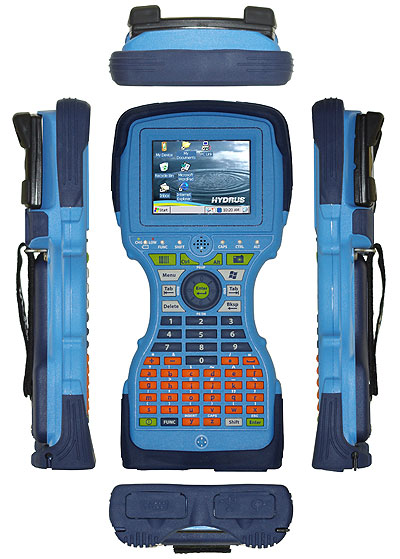
Like the company's JETT.eye, the Hydrus has a 5.17-megapixel (4-megapixel processed) CMOS color imager with auto focus an illuminator that can take pictures or read bar codes (Code 128, Code 39, Code 2 of 5, EAN-13, PDF417, UPC and several more). Special development and application software is available for the camera.
The Hydrus uses one of the fastest currently available PXA processors (the 624MHz version of Marvell's PXA270) with easily configurable and customizable current and legacy components. It runs Microsoft Windows CE 5.0, includes Bluetooth and 802.11b WiFi, has 256MB of RAM plus 2GB to 32GB of Flash storage. The display is a landscape-mode 320 x 240 pixel outdoor viewable color LCD measuring 3.5 inches diagonally. There is a 55-key alphanumeric keypad that is fully customizable. Keys are shear-proof and can be operated with gloves and provide a keyboard-like feel.
The Hydrus can be equipped with RFID reader, laser scanner, GPS, imagers, cameras and even custom peripherals via the company's JETT*PACK expansion module technology.
But now let's take a closer look at the Hydrus:
Taking a look inside
The Hydrus achieves waterproofing via a clamshell construction and O-rings. A sharp lip goes around the perimeter of the top part and pressure-fits onto a rubber O-ring that goes around the perimeter of the bottom part. This kind of seal is highly effective if the two halves of the unit are properly secured together, and as long as the O-ring and corresponding lip surface are not compromised in any way. The halves are secured together via 16 small screws. The top and bottom rubber bumpers have two hooks each that secure them to the body. They, as well as the rubber plugs that seal the connectors at the bottom, can easily be replaced should they ever get damaged.
As you can see below, the overall layout and board circuitry inside the Hydrus are extremely clean and emanate a feel of highest quality. The main board is a tight custom-fit inside the Hydrus. There is no doubt that a lot of thought and good engineering and manufacturing went into this product.
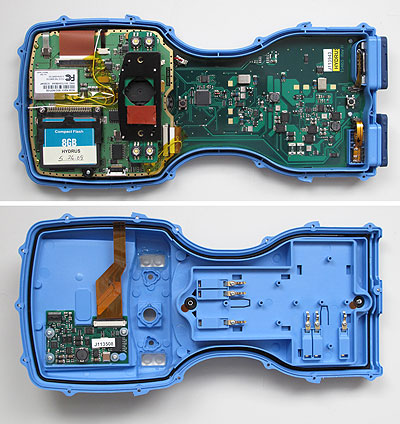
The WiFi module (center left) is a Summit Data SDC-MCF10G 802.11G Miniature CF Module with antenna connectors. It is a high-performance unit designed for business-critical applications that need to reliably operate in harsh environments (including extreme temperatures). The module has very good transmit power, receiver sensitivity, and delay spread, all at very low power consumption. A special management and monitoring app called the Summit Client Utility is included. We got an unintended demonstration of the sensitivity of the Summit Data WiFi module when I sat at the bottom of the pool with it at maybe seven feet and it detected a nearby wireless LAN and asked if it should connect to it. That's pretty impressive.
Flash is via an industrial 8GB Compact Flash card (bottom left) specially secured in a subframe and held in place with a stopper.
The imaging subassembly (see the black module in the picture above and the closeup below) is unexpectedly large. This is probably due to the selection of a fairly sophisticated auto-focusing module as opposed to the much simpler "cameras" found in cellphones and such. Two lasers are used to focus, and shutter and aperture can be controlled, allowing for higher quality, and more flexible, image capture. Two Technologies also offers their eye·WARE solution that allows integrators and developers to create all sorts of imaging applications and also pass information generated by the imager, such as storage path and bar code information, on to applications.
Four clear lenses used by the imager and lighting system of the Hydrus are glued on from the inside. Under extreme pressure they could be pushed in. I'd rather see them removable from the outside, so that pressure will only press them harder into their seating.
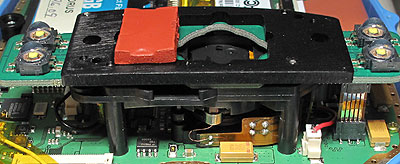
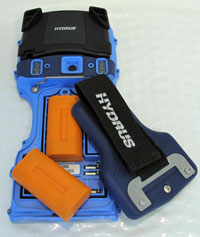 The battery compartment is open towards the inside of the unit, and so it is equally important that the battery compartment cover, equipped with its own O-ring/pressure seal is secured properly and checked for damage each time the cover is removed and put back on.
The battery compartment is open towards the inside of the unit, and so it is equally important that the battery compartment cover, equipped with its own O-ring/pressure seal is secured properly and checked for damage each time the cover is removed and put back on.
The Hydrus uses two 7.4 Volt/2,500mAH Lithium-Ion rechargeable smart batteries for a total of 37 watt-hours. That is more battery power than many notebook computers have. Given the much smaller power draw of a Windows CE-based handheld, it is not surprising that battery life is phenomenal (40+ hours according to Two Technologies). The batteries, by the way, are custom-designed for the Hydrus. They slide into the housing and cannot fall out when the battery cover is opened.
The Hydrus' large keyboard has its own sealing method that we could not examine in detail. The ports at the bottom of the unit and completely sealed in a clear silicon compound (the DB-9 RS232 connector, however, showed a bit of rust after prolonged immersion).
For certain types of expansion, the Hydrus uses the PACK system with expansion units piggybacking onto the back of the unit. They communicate with the computer through an 18-pin surface mount pressure contact and snap onto the Hydrus with an intricate mechanism.
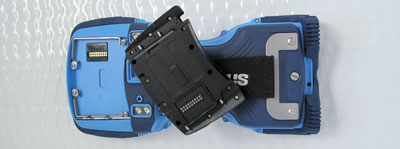
OS and software
The Hydrus comes with Windows CE 5.0, a very compact and very efficient operating system that was designed for a broad range of embedded/industrial systems and products. It has plenty of programming support and a rich subset of Microsoft Win32 APIs. While many people primarily know Windows CE from Pocket PCs and smartphones, Windows CE is actually a powerful multi-threaded, multi-tasking, fully preemptive OS environment was targeted from the start specifically toward hardware with limited resources. As for software development environments, there are:
- Visual Studio 2005 (Visual C#, Visual C++, Visual Basic, etc.)
- The Hydrus developers kit (manuals, SDKs, numerous utilities)
- The eye·WARE software suite
Why Windows CE instead of one of the recent variants of Windows Mobile with all its bells and whistles and prettier user interface? Primarily because Windows Mobile, which is really just Windows CE with a certain selection of modules and a consumer-oriented user interface, is less flexible when it comes to creating a very specific build and set of features for a custom application or custom device.
Handling
Unlike some handhelds that fit into shirtpockets, the Hydrus is quite large. With a footprint of about 5 x 11 inches, a thickness of about two inches, and weighing 2.5 pounds, this is a substantial tool for the job. Ergonomic design with a distinctive "waist," however, makes it easy to hold and operate.
The Hydrus' standard 55-key keyboard is about as extensive as it gets on handhelds. Color coding separates the keys into four groups:
- A 30-key alpha keypad with ABCD layout has orange keys with dark blue letters
- A 10-key numeric keypad uses blue keys with white letters
- Shift, tab, menu, delete, backspace and the Windows key are white with blue labels
- Special keys (scan, imager, alt, ctrl, enter and power) are green with blue labels.
Two Technologies provides a special Kbdtool.exe utility that developers can use to assign and change key mappings for all keys. Two Technologies can supply custom-labeled keys and keypads.
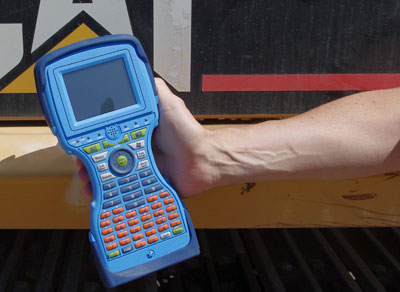
The camera/imager
The camera/imager in the Hydrus is far more capable and complex than the cameras usually found in cellphones or handheld computers. It is a 5.17 megapixel color CMOS sensor that can take pictures (about 4 megapixel once processed) and also read bar codes. Maximum resolution is 2048 x 1944 pixel. A complex stepper-motorized autofocus mechanism means it can take sharp images, and it can do that even under difficult lighting conditions thanks to illumination via four bright white LEDs (though only for close-ups) and two focus-assist lasers (also primarily used for close-ups).
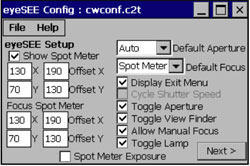 Everything is controlled by eye·WARE, which is a software utility suite for the configuration of image capture and barcode scanning, as well as for generating, displaying and storing images. eye·WARE is as much a developer tool as an application as evidenced by some of the very direct controls (like typing "L" or "V" to turn the lamp or the viewfinder on or off). It's quite sophisticated, however, and you get things like focus and over/under exposure indicators that can greatly help in taking good pictures. The picture to the right above shows one of the several eye·WARE configuration screens. Everything is controlled by eye·WARE, which is a software utility suite for the configuration of image capture and barcode scanning, as well as for generating, displaying and storing images. eye·WARE is as much a developer tool as an application as evidenced by some of the very direct controls (like typing "L" or "V" to turn the lamp or the viewfinder on or off). It's quite sophisticated, however, and you get things like focus and over/under exposure indicators that can greatly help in taking good pictures. The picture to the right above shows one of the several eye·WARE configuration screens.
A separate eye·D utility lets you customize how the imager does barcodes and how the information is passed on to applications. It's even possible to configure options for supported type of barcode.
Underwater testing
IP68 sealing means a device is totally protected against dust and also totally protected against immersion into water. There are various level of waterproofing, ranging from being able to handle a bit of rain or spray all the way to really being waterproof. The Hydrus falls into the second category. That comes in handy if the device gets dropped into a puddle or even deeper water on a job -- it can happen. 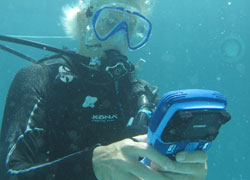 We specifically inquired with Two Technologies as to their definition of waterproof, and the answer was "operating at three meters (ten feet) for 3+ hours." There are a number of waterproof cameras from Olympus, Pentax, Panasonic or Canon that can do that, but they have far fewer buttons to protect, fewer ports, and they don't have touch screens. We decided to do a limited test on SCUBA, 20 minutes operating at about eight feet. The Hydrus passed with flying colors. The touch screen worked so well underwater that we could even take notes in handwriting recognition. And since the Hydrus even managed to locate a nearby wireless LAN, we probably could have even browsed the web or done email underwater. We specifically inquired with Two Technologies as to their definition of waterproof, and the answer was "operating at three meters (ten feet) for 3+ hours." There are a number of waterproof cameras from Olympus, Pentax, Panasonic or Canon that can do that, but they have far fewer buttons to protect, fewer ports, and they don't have touch screens. We decided to do a limited test on SCUBA, 20 minutes operating at about eight feet. The Hydrus passed with flying colors. The touch screen worked so well underwater that we could even take notes in handwriting recognition. And since the Hydrus even managed to locate a nearby wireless LAN, we probably could have even browsed the web or done email underwater.
Now, while the Hydrus is indeed waterproof, handheld computers really aren't designed for underwater computing. It is theoretically possible to use the unit to do some underwater photography (perhaps damage assessment or documentation), but all we really wanted to see was whether the Hydrus is really waterproof and functional underwater. It is.
Bottomline
The Hydrus by Two Technologies is a very flexible and very versatile handheld computing tool for tough jobs. With its ultra-rugged design, very long battery life and easily customizable keyboard, the Hydrus is perfectly suited for all sorts of outdoor applications in vertical markets where durability, operational longevity as well as flexible operations are absolutely mandatory. Its integrated 5 megapixel CMOS imager doubles as a scanner and adds additional versatility. Add a very high degree of dust and waterproofing, and you have a device that can be used almost anywhere and for almost any application.
|



